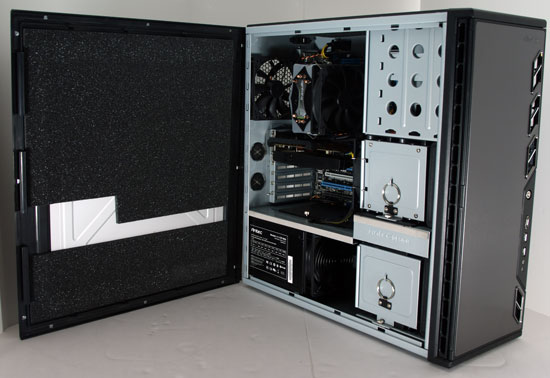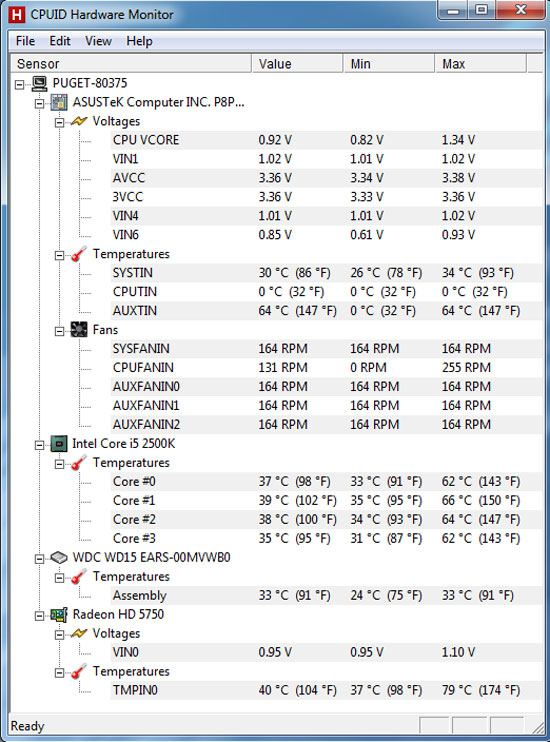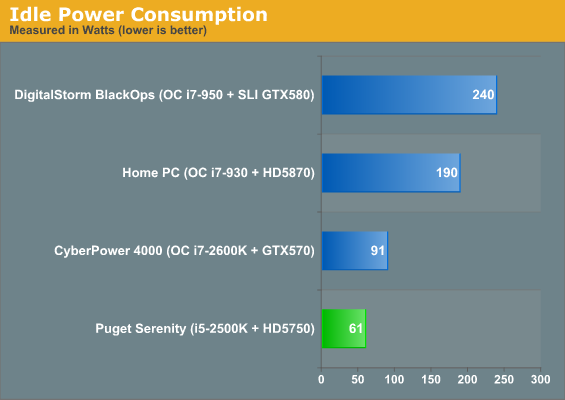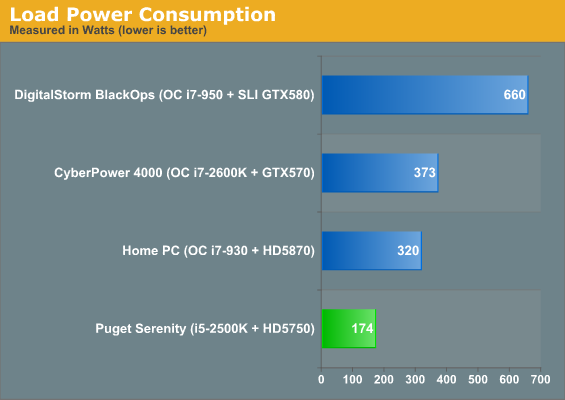Puget Systems Serenity SPCR Edition: Blissful Silence
by Dustin Sklavos on February 10, 2011 12:00 AM EST- Posted in
- Systems
- Intel
- Radeon
- Sandy Bridge
- Puget Systems
- Serenity SPCR
Build, Noise, Heat, and Power Consumption
Given the somewhat exotic nature of Puget Systems's Serenity SPCR Edition tower, it's reasonable to assume that there just aren't any good corners to cut. I'm happy to report that, having examined the system, Puget Systems simply couldn't and didn't.
What makes the build particularly interesting compared to the others is that, as I mentioned in the introduction, this really is a custom build, not just a melange of carefully chosen and assembled parts. Take a look inside and see what I mean.

Seeing the additional foam padding on the inside of the side panel when I had to remove the internal packing was a major cue, and the foam has been carefully cut to fit around the internals of the Antec P183 case used for the build. From the photo you can see three major points in Puget Systems's favor: quality case, quality power supply, and additional custom sound dampening. What's harder to see is that Puget Systems removed the Antec Tricool fans from the case and replaced them with silent Scythe 120mm fans. They've also bracketed an additional fan to the top hard drive tray, and they've removed the top exhaust fan and covered the vent with foam.
Another interesting point is the use of an air cooler instead of a watercooling system on the processor. I've reviewed more desktops with watercoolers than not and they're generally considered among the quietest ways to go, but here Puget Systems opts to use an air cooler—the Gelid Tranquilo—with a silent fan. They also carefully tuned the fan speeds in the ASUS board's UEFI to ensure silent running.
Certainly building the entire system for low noise is going to mean running a little hotter than normal, though, right? Interestingly, that's not the case.

Check out those thermals. The Serenity SPCR Edition keeps everything running remarkably frosty, and that's due in no small part to the attention paid to airflow inside the case. The P183 was already an excellent case with great thermals (we actually have a review unit on hand and we'll be posting a case review in the coming months), but the modified cooling produces airflow moving in effectively a straight line through the tower with minimal turbulence, allowing the fans to run at low speeds without compromising thermal performance. Even the Radeon doesn't crack 80C.
With those temperatures and the system's configuration in mind, these power consumption figures should come as no surprise to you:


We tested power consumption by idling at the desktop, and then running our Left 4 Dead 2 timedemo. In my experience, very few games are capable of pulling as much power from a system as Left 4 Dead 2 can. Something about the Source engine's relatively frugal usage of graphics hardware lets the processor and video power consumption scale well together.
Under load, Puget Systems's Serenity SPCR Edition draws less power than my fairly frugal desktop does at idle. Sandy Bridge has proven to be stunningly power efficient in the testing we've been able to do (we really can't wait to get our hands on more Sandy Bridge-equipped notebooks), and combining that with the already efficient Radeon HD 5750 keeps power consumption low. The next system up on the list—my home tower—draws nearly twice as much power under load. That increase in power draw may be commensurate with the increase in gaming performance, but keep in mind the i5-2500K is able to handle processor-intensive tasks much more efficiently than the i7-930.
















139 Comments
View All Comments
Anchen - Friday, February 11, 2011 - link
What the hell i the waste? It's not like an 850W psu draws more power, it'll only use as much as the system needs. It comes out cheaper, is effectively silent. And if you knew anything about PSU's you know you certainly don't want to continuously run at 90% of your PSU's capacity which if you were gaming with a single 6970 you would. A PSU's best efficiency is at 50% load.HangFire - Tuesday, February 22, 2011 - link
"Seasonic X-400. Game,set,match. No fan, will go up to 400watts. Whats Puget excuse?"flemeister already answered your question. They are counting on the always-on CP-850 for needed airflow. An X-400 would be silent but would only add heat to the case, not remove it.
Now... What excuse for your continued ignorance?
strikeback03 - Thursday, February 10, 2011 - link
Who called it a gaming machine? Do you think that is all Anandtech can review?michal1980 - Thursday, February 10, 2011 - link
Look at the gaming review done on this machine. Look at the author's off base, ignornant comments on 30fps. And the rant about 100-150fps. For the writer/anandtech to ever try to stretch this into a gaming machine is crap.strikeback03 - Friday, February 11, 2011 - link
I don't think they were trying to call it a gaming machine at all. They were putting it through their standard suite of tests, which includes games. This is the same as putting an Atom netbook through the standard laptop test suite, even though they know it will be producing single-digit FPS scores and is completely unsuited to that use. I did not read this article as trying to show this was any more than adequate as a gaming platform, it seemed clear to me that the point of this build is a lot of CPU power in as silent a rig as possible. Obviously if gaming is your primary use, unless you game in a crypt with sound off this probably shouldn't be how you spend $2k.Also, 16FPS was in 1 game at their Ultra preset. You could have chosen to point out the 53 FPS it scored in the chart above the one you referenced, which would be just as much of an outlier.
pcfxer - Thursday, February 10, 2011 - link
Parts cost money, but I guarantee no one on here could achieve the same thing with the amount of research and testing that has been applied to this system. Apparently people want Engineers to work for free.IBM doesn't charge you only for parts, GM/ford/etc don't charge you just for parts and your local bike shop doesn't charge for just parts. YES! Unless you have an anechoic chamber with a noise floor below 10dB and years of experience (engineering degree or two) you can achieve this.
The chamber costs money, the engineer costs money, the time costs money. DEAL WITH IT! You couldn't do better!
MeanBruce - Thursday, February 10, 2011 - link
You are right, and you are wrong! Puget should get paid for the work they have done on this PC, absolutely!!! Out of all the parlor shop groups they really seem to know what they are doing, and for those Silent Enthusiasts out there who don't want to put together a PC this is a great way to go, certified 11db is well worth the price if you haven't experienced a PC this quiet it will change your entire computing experience!! But please don't let people believe you cannot do this yourself, you can, without an enginneering degree and without a sound chamber! My loudest component was a 10db Noctua fan that I replaced with a 6db Noctua fan, 200mm case fans attenuated down to 8db, rear case fan 6db, video card fan in auto mode 1335rpm again between 8 and 10db, how do I know? Because it's quieter than my 10db fan and louder than my 6db fan! CPU cooler Noctua NH-D14, it's so large so much surface area it needs no fan 0db. Ssd 0db! You don't need a degree or have to hire an engineer to put together an sub-10db PC, if you enjoy putting a PC together just do it yourself! ;)mino - Thursday, February 10, 2011 - link
But!You would need a brain. Those are a much harder to get than degrees.
PartEleven - Friday, February 11, 2011 - link
Wait? What? SPCR's own anechoic chamber has a noise floor of 10.21 db. Even they have a hard time measuring the noise from this system.In reading your post it sounds like you are basing your own system's sound using your own subjective hearing and comparing it to a fan advertised at 10db. You fail to realize that nearly every sound rating advertised on the package of a fan is misleading at best. There's no way your system is 10db.
Taft12 - Friday, February 11, 2011 - link
Nor do sound waves exist in a vacuum in the real world. More than one fan will create a multiplying effect leading to a db measure higher than the "rating" of any single fan.